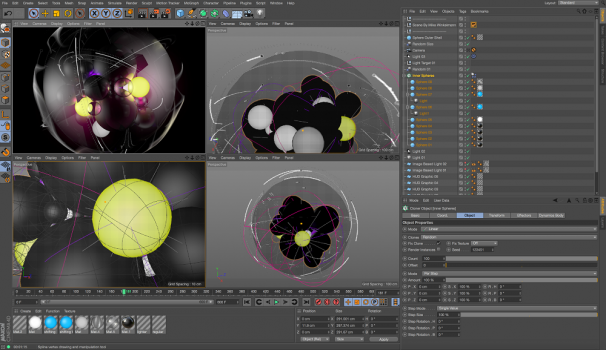
Is Maxon Cinema 4d better than Blender?
These two famous 3D software packages entered the animation industry on opposite ends of the spectrum many years ago. Maxon’s Cinema 4D was an industry leader, and was used by big budget studios across all art industries. Then there was Blender, the open source free software that was noticeably lacking on all fronts when compared to the top program names in the animation industry.
So much has changed, and while Cinema 4D is still an industry titan being used in countless Hollywood movies, Blender has been closing the gap year after year. Let’s take a look at the strengths of both animation programs.
 Maxon Cinema 4D Updates
Maxon Cinema 4D Updates
Cinema 4D is a 3D modeling, animation, motion graphic, and rendering application developed by Germany’s Maxon Computer GmbH. It has all the bells and whistles you could want, and in September 2018 it released Cinema 4D R20, and added a few more features as well.
Procedural animation is possible with Cinema 4D using its node based XPresso editor, which has options for animations without keyframes, or by using Python programming. HUD (Heads Up Display) updates make usability easier, and the Powerslider, Animation Dot, Dope Sheet, and F-curve feature enhancements all offer quality of life updates to keyframing. Motion Clips also allow you to create libraries of animations and blend them together on your characters. Other advanced features are Quaternion tags, Cappuccino, and Auto Redraw for dynamic IK.
Advanced character animation comes with Character Component, Character Object, CMotion walk cycles, Interaction Tag, and Pose Morph. The Cinema 4D MoGraph comes with Cloner, Shader Effector, Sound Effector, Splice Effector, Delay Effector, the highly popular Voronoi Fracturing, and MoDynamics for other physics libraries. The simulation features include all of the usual ones, as well as the cutting edge Thinking Particles that are advanced rule-based particle systems.
As far as pricing goes, Maxon has about two dozen different customizations of Cinema 4D R20, including Prime, Broadcast, Visualize, Studio, and BodyPaint. Artists can either purchase them outright, or buy short term three and six month licenses, or discounted upgrades for those who have previous versions. All of these options range from as low as $400 to as much as $3,695. A standard package is Cinema 4D Studio R20 3-Month Short-Term License for $600, or a six month license for $1,100.
 Blender 2.79 Updates
Blender 2.79 Updates
Blender's animation features include the following: automated walk-cycles along paths, character animation pose editor, Non Linear Animation (NLA) for independent movements, IK forward/inverse kinematics for fast poses, and sound synchronization. Posing characters gets easier and easier each year in Blender. Its rigging tools include envelope, skeleton and automatic skinning, easy weight painting, mirror functionality, bone layers, colored groups for organization, and B-spline interpolated bones.
Other improvements have come to Denoise for lighting and rendering, film color management, PBR Shader based on the Disney model, faster OpenCL and parity with Nvidia CUDA technology for faster renders, support for subsurface scattering, Shadow Catcher, surface deform modifier, improved Alembic import and export, more Python API add-ons.
Speaking of add-ons, check out this huge list of new add-ons: Dynamic Sky, Archipack, Magic UV, Mesh Edit Tools, Skinify, Display Tools, Brush Menus, Btrace, Is Key Free, Turnaround Camera, Auto Mirror, Camera Rigs, Snap Utils Line, Add Advanced Objects, Export Paper Model, Kinoraw Tools, Stored Views, Render Clay, Auto Tracker, Refine Tracking Solution, Materials Library VX, Mesh Tissue, Cell Fracture Crack It. These add-ons were also updated: Collada, POV-Ray, OBJ, Rigify, Ant Landscape, Add Curve Extra Objects, Viewport Pie Menus, Blender ID, Node Wrangler.
The Blender fans keep busy and it’s amazing how much progress has occurred in the past decade. Over one thousand bugs have been fixed since just the previous Blender 2.78 version alone! It’s exciting to see Blender being used more often in the indie game development industry. The community continues to thrive, flourish, and improve.
Animation Schools to Consider
- San Francisco & Online
- Top 50 Nationally for Animation (#14) - 2021
- Top 50 Nationally for Game Design (#37) - 2021
- Top 50 Nationally for Illustration (#24) - 2021
- Top 50 Nationally for Graphic Design (#38) - 2021
- Winter Park, FL & Online
- Computer Animation - Bachelor's - Online & Campus
- Game Programs - Bachelor's & Master's - Online & Campus
- Graphic Design & Digital Arts - Bachelor's - Online & Campus
- Film & Digital Cinematography - Bachelor's & Master's - Online & Campus
- Mobile Development - Bachelor's - Online
- Simulation & Visualization - Bachelor's - Campus
- Top 50 Nationally for Animation (#11) - 2021
- Top 50 Nationally for Game Design (#10) - 2021
- Top 25 in the South for Graphic Design (#10) - 2021
- Online



